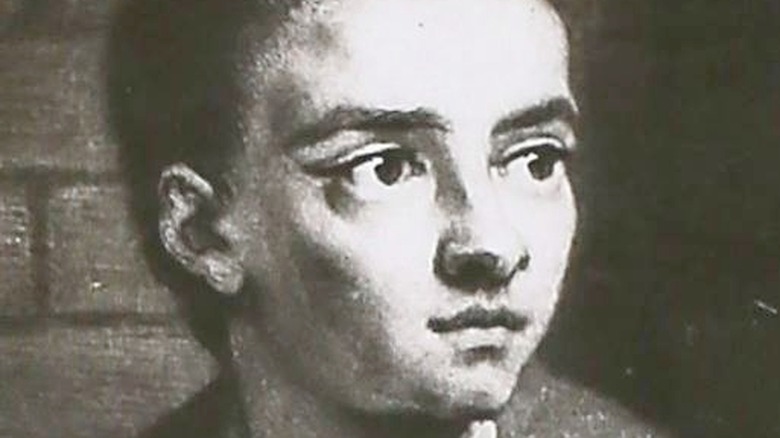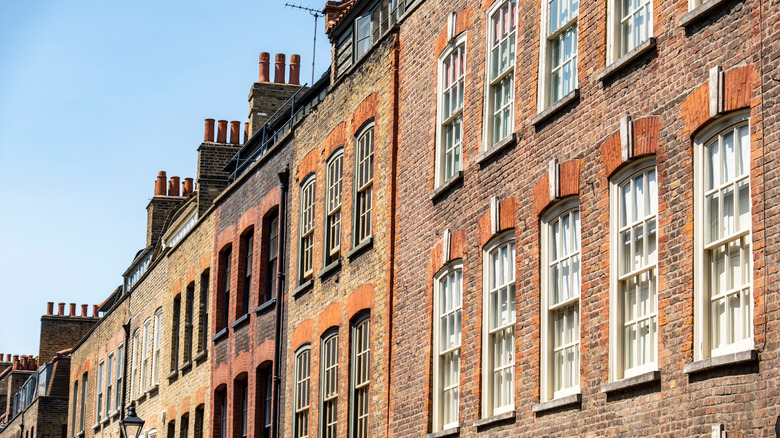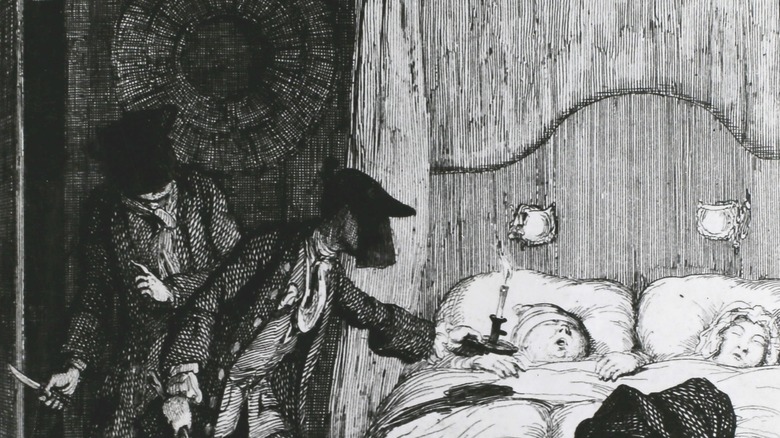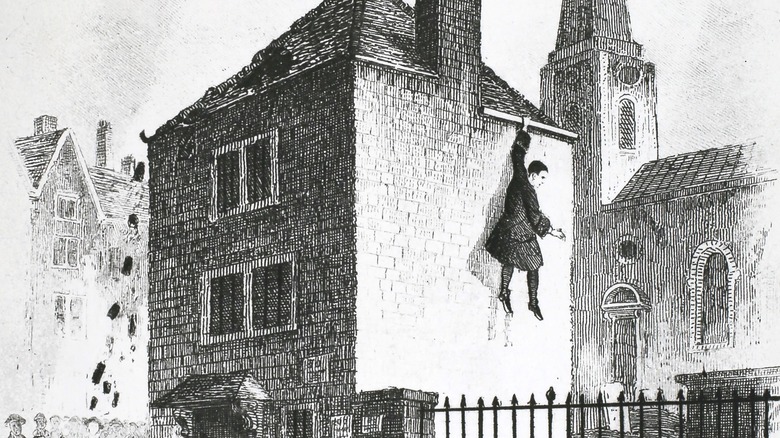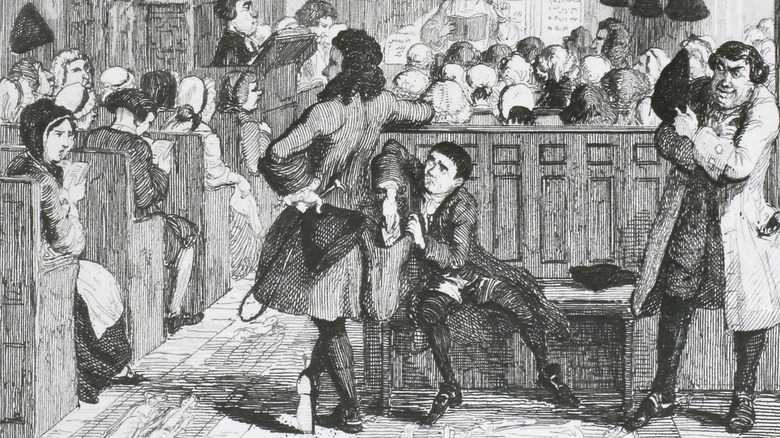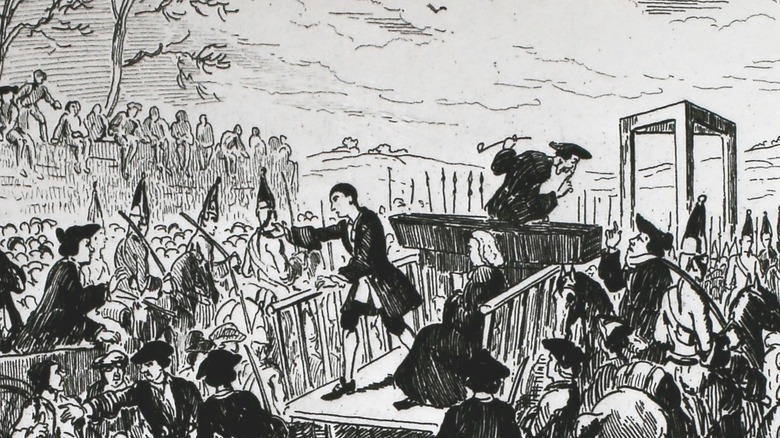Nearly A Third Of London Watched This Famous Execution
Public executions used to draw big crowds. Sure, perhaps a portion of that was because onlookers had some kind of morbid curiosity about what would happen or wanted to see a criminal get their comeuppance. However, most were probably there because it was something to do in a time before TV and when an errant sneeze signaled the likely start of a fatal illness. While public executions are usually thought of as a vestige of the past, they still happen in some countries around the world like Iran, Saudi Arabia, North Korea, and Somalia (via World Atlas).
In 18th century England, thousands of people turned out for the public execution of a notorious thief whose numerous escapes from prison captured the people's imaginations. His name was Jack Sheppard, and according to the Old Bailey, the crowd witnessing his execution in 1724 was 200,000 people strong, equivalent to nearly a third of London's population of 630,000 at the time.
Jack Sheppard's early life and upbringing
According to Britannica, Jack Sheppard — or John Sheppard, as he was sometimes known — was born on December 2, 1702, and grew up in Spitalfields, London. Back then, Spitalfields was a rough part of the city that was frequented by criminals and sex workers (via Historic UK). Sheppard's family was poor and he grew up in a workhouse, a type of living accommodation where people were given a place to live in exchange for work. Despite this, Sheppard learned to read and write, somewhat unusual for the time. He also apprenticed with a carpenter through his teenage years. The skills he acquired were later put to use, only not in the way they were intended.
Sheppard eventually fell into the criminal underworld, where he fraternized with highwaymen and thieves. According to the BBC, Sheppard was becoming an accomplished carpenter but abandoned the profession with just a year left in his apprenticeship and turned to the life of crime that made him famous.
Jack Sheppard made friends with criminals
Much the same way that Sheppard was a carpenter's apprentice, he received a similar, quasi-apprenticeship with some of the most infamous criminals of the day, per the BBC. According to Spitalfields Life, Sheppard started frequenting the Black Lion, a public house or tavern, known to be a popular hangout for criminals and their ilk. There, Sheppard met Elizabeth Lyon, known to history as Edgeware Bess. Edgeware Bess — her nickname came from the town where she was born — was a sex worker.
Sheppard started committing crimes while still a carpenter's apprentice. His typical M.O. was to break into the houses he was working at as a carpenter, then pass off anything he grabbed to Bess. The thinking was that she would draw less attention walking around with the stolen items than he would (via Exclassics). Another one of Sheppard's criminal cohorts and a frequent presence at the Black Lion was a notorious highwayman named Joseph "Blueskin" Blake, per Historic UK.
Sheppard was captured — and escaped — multiple times
Sheppard's crimes ramped up, but he was an amateur compared to some of his contemporaries, and eventually wound up in the clutches of law enforcement (via Historic UK). His first arrest landed him in prison on a pick-pocketing charge. According to Britannica, he put together a successful escape attempt in April 1724 by breaking a chair and using it to create a hole in the ceiling of his jail cell. Then he climbed onto the roof and escaped by blending in with a crowd of people, per the BBC.
However, Sheppard had a habit of returning to one of his favorite watering holes, the Black Lion, after his escapes, which made him pretty easy to track down, and was usually pretty drunk by the time anyone came looking for him.
His second and third escapes were both accomplished the same way: by having visitors bring him tools which he used to free himself from his cell. The second time he was imprisoned, he was allowed to share a cell with Edgewater Bess, and he used her clothes and his to make a rope that he used to complete his escape. On the third escape, once out of his cell, he left the prison disguised as a woman. Sheppard's fourth escape was done by climbing out onto the roof of the prison, much like he did in his first escape, only this time he accessed it by climbing up a chimney.
Jack Sheppard's popularity
These numerous escapes — all of which were accomplished over the course of just a few months — were reported by newspapers of the day. Sheppard's escapes made him a popular anti-hero with the general public and even royalty. According to the BBC, Sheppard became a popular subject in the art world and appeared in painting and as a character in plays. King George reportedly commissioned a painting of Sheppard, though it was never completed.
Sheppard tried to capitalize on his newfound, ill-gotten fame by releasing an autobiography with the catchy title "A Narrative of all the Robberies, Escapes etc. of John Sheppard." According to Historic UK, the book was ghostwritten by Daniel Defoe, best known for writing "Robinson Crusoe."
His growing popularity started to become a concern and Sheppard was sentenced to death by hanging. However, he had something planned: He was going to put on one last show, and perhaps one final escape.
Sheppard's execution drew thousands
Sheppard's fame was most apparent on the day he died. His execution took place at Tyburn, which according to Historic UK was a common place for criminal executions. It's been reported that as many as 200,00 people showed up to see the boyish, 5-foot, 4-inch-tall, 22-year-old executed. His path to the gallows was full of sobbing women. Copies of his autobiography were sold at the execution, which had morphed into more of a public spectacle.
Sheppard was searched and found to have a knife on him at his execution (via the BBC). This led to speculation that Sheppard had planned to escape from his hanging, and that seems to have likely been the case.
According to Historic UK, Sheppard is thought to have had friends prepared to grab his body after he was hanging for 15 minutes. This was the required time for a body to stay hanging from the gallows, but on some occasions, it wasn't enough time for the condemned to die. However, the immense crowds made it impossible for anyone to get through the crowd and get to the young criminal, and he died from asphyxiation.
